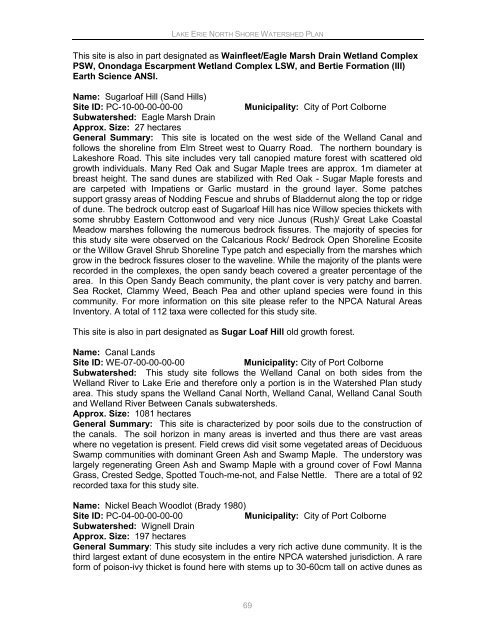Lake Erie North Shore Watershed Plan - Niagara Peninsula ...
Lake Erie North Shore Watershed Plan - Niagara Peninsula ...
Lake Erie North Shore Watershed Plan - Niagara Peninsula ...
Create successful ePaper yourself
Turn your PDF publications into a flip-book with our unique Google optimized e-Paper software.
LAKE ERIE NORTH SHORE WATERSHED PLAN<br />
This site is also in part designated as Wainfleet/Eagle Marsh Drain Wetland Complex<br />
PSW, Onondaga Escarpment Wetland Complex LSW, and Bertie Formation (III)<br />
Earth Science ANSI.<br />
Name: Sugarloaf Hill (Sand Hills)<br />
Site ID: PC-10-00-00-00-00<br />
Municipality: City of Port Colborne<br />
Subwatershed: Eagle Marsh Drain<br />
Approx. Size: 27 hectares<br />
General Summary: This site is located on the west side of the Welland Canal and<br />
follows the shoreline from Elm Street west to Quarry Road. The northern boundary is<br />
<strong>Lake</strong>shore Road. This site includes very tall canopied mature forest with scattered old<br />
growth individuals. Many Red Oak and Sugar Maple trees are approx. 1m diameter at<br />
breast height. The sand dunes are stabilized with Red Oak - Sugar Maple forests and<br />
are carpeted with Impatiens or Garlic mustard in the ground layer. Some patches<br />
support grassy areas of Nodding Fescue and shrubs of Bladdernut along the top or ridge<br />
of dune. The bedrock outcrop east of Sugarloaf Hill has nice Willow species thickets with<br />
some shrubby Eastern Cottonwood and very nice Juncus (Rush)/ Great <strong>Lake</strong> Coastal<br />
Meadow marshes following the numerous bedrock fissures. The majority of species for<br />
this study site were observed on the Calcarious Rock/ Bedrock Open <strong>Shore</strong>line Ecosite<br />
or the Willow Gravel Shrub <strong>Shore</strong>line Type patch and especially from the marshes which<br />
grow in the bedrock fissures closer to the waveline. While the majority of the plants were<br />
recorded in the complexes, the open sandy beach covered a greater percentage of the<br />
area. In this Open Sandy Beach community, the plant cover is very patchy and barren.<br />
Sea Rocket, Clammy Weed, Beach Pea and other upland species were found in this<br />
community. For more information on this site please refer to the NPCA Natural Areas<br />
Inventory. A total of 112 taxa were collected for this study site.<br />
This site is also in part designated as Sugar Loaf Hill old growth forest.<br />
Name: Canal Lands<br />
Site ID: WE-07-00-00-00-00<br />
Municipality: City of Port Colborne<br />
Subwatershed: This study site follows the Welland Canal on both sides from the<br />
Welland River to <strong>Lake</strong> <strong>Erie</strong> and therefore only a portion is in the <strong>Watershed</strong> <strong>Plan</strong> study<br />
area. This study spans the Welland Canal <strong>North</strong>, Welland Canal, Welland Canal South<br />
and Welland River Between Canals subwatersheds.<br />
Approx. Size: 1081 hectares<br />
General Summary: This site is characterized by poor soils due to the construction of<br />
the canals. The soil horizon in many areas is inverted and thus there are vast areas<br />
where no vegetation is present. Field crews did visit some vegetated areas of Deciduous<br />
Swamp communities with dominant Green Ash and Swamp Maple. The understory was<br />
largely regenerating Green Ash and Swamp Maple with a ground cover of Fowl Manna<br />
Grass, Crested Sedge, Spotted Touch-me-not, and False Nettle. There are a total of 92<br />
recorded taxa for this study site.<br />
Name: Nickel Beach Woodlot (Brady 1980)<br />
Site ID: PC-04-00-00-00-00<br />
Municipality: City of Port Colborne<br />
Subwatershed: Wignell Drain<br />
Approx. Size: 197 hectares<br />
General Summary: This study site includes a very rich active dune community. It is the<br />
third largest extant of dune ecosystem in the entire NPCA watershed jurisdiction. A rare<br />
form of poison-ivy thicket is found here with stems up to 30-60cm tall on active dunes as<br />
69
















